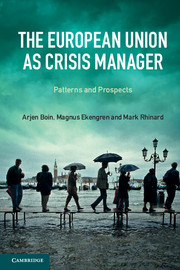3 - The EU as global crisis manager
How emerging tools shaped ambitious policy aims
Published online by Cambridge University Press: 05 August 2013
Summary
With so many cooks in the kitchen, it is, in some ways, amazing that any broth is produced at all.
(Howorth and Menon 2009)This is the European way of doing things: a comprehensive approach to crisis prevention and crisis management; a large and diversified tool box; a rapid response capacity; playing our role as a global actor.
(Javier Solana)The EU steps on the international podium
In January 2003, the EU embarked on its first crisis management mission abroad. The EU Police Mission in Bosnia and Herzegovina (EUPM) would last seven years and had a staff capacity of 540 at its peak. The EUPM aimed to establish and train a multiethnic police service and to assist local authorities in conducting large-scale crime investigations. By building and strengthening key institutions in the criminal justice sector, the mission sought to facilitate a return to normalcy in a war-torn region (Merlingen 2009).
In the summer of 2003, an EU military mission landed in the Congo. Militias had killed hundreds of civilians. Thousands sought protection from the UN mission (then dubbed “MONUC”). When the UN battalion could not protect the terrified population, the UN called on the EU to send forces. The EU mission (ARTEMIS) of approximately 2000 soldiers drove the militias out within weeks and handed control back to the United Nations.
- Type
- Chapter
- Information
- The European Union as Crisis ManagerPatterns and Prospects, pp. 52 - 99Publisher: Cambridge University PressPrint publication year: 2013

